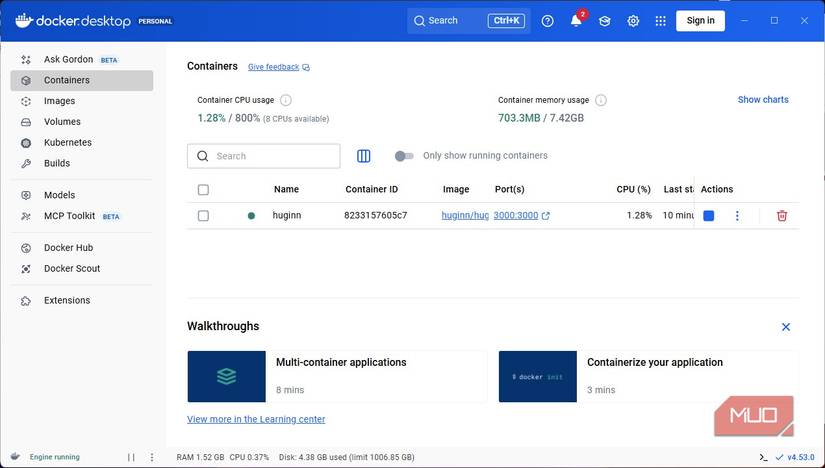Laravel News Links
Boost Laravel E-commerce Performance: Proven Strategies for Speed, Reliability & Order Security
Laravel News Links
LEGO Stud Measure Tool
https://theawesomer.com/photos/2025/12/lego_stud_measure_tool_t.jpg
Until now, we thought the only tool for LEGO projects was the brick separator. Brick Science shows off another handy tool for custom LEGO builds. The Stud Measure is a retractable tape measure that’s marked with single stud increments on one side, and brick heights on the other. Its end piece is compatible with LEGO studs, so you can snap it in place.
The Awesomer
Laravel Snowfall Package
Laravel News Links
Laravel .env.example – The Definitive Guide
Laravel News Links
I never expected an open-source app to beat IFTTT and Zapier — but this one did
https://static0.makeuseofimages.com/wordpress/wp-content/uploads/wm/2025/11/a-macbook-on-a-table-showing-the-huginn-automation-app.jpg
I’ve used more automation platforms than the average person — IFTTT (If This Then That), Zapier, Make, n8n — plus a few obscure ones that never went past beta. What every one of them did was box me into templates. This throttled my workflow and failed to show the real strength of premium tiers. I settled for living within their limits, even when it meant holding back my ideas.
A friend recommended Huginn, and I was intrigued by how fundamentally different it is. No glossy shortcuts, no paid add-ons, just raw access, full ownership, and the satisfaction of finally building my own automations rather than renting someone else’s. It’s surprising how it subtly outperforms some of the big names. It’s become one of my favorite free automation tools.
Why Huginn’s architecture outclasses Zapier and IFTTT’s paywalled features
If you used IFTTT or Zapier, you’re familiar with the trigger-and-action structure. Huginn’s implementation is different: it builds workflows using a continuous agent-to-event-to-agent chain. This approach delivers an immediate advantage with multi-step logic, conditional paths, and data shaping as core, fundamental, and free parts of Huginn. Typically, these are paid features in several tools, including Zapier and IFTTT.
The agents are small workers that produce structured JSON events. These events produce scenario chains that act like small automation ecosystems that can branch, merge, and loop through other agents, rather than acting as isolated tasks.
Huginn allows unlimited chaining, dynamic routing, and even native scripting, replacing expensive features in Zapier like Webhooks by Zapier, Code by Zapier, and Multi-Step Zaps, without limiting how often or how deeply you automate.
- OS
-
Linux, macOS, Windows
- Price model
-
Free
Huginn is an open-source, self-hosted system which allows you to build automated tasks online using "agents". Agents can monitor websites, gather data, or trigger actions.
You fully own your data, your workflows, and the entire stack
The freedom of self-hosting—and the responsibility that comes with it
Huginn runs on your machine, making it fundamentally different. Triggers don’t pass through third-party companies, events aren’t logged on other platforms, and API keys don’t leave your computer. You don’t get this level of sovereignty from other platforms, which is ideal if you’re handling sensitive data.
However, owning the entire stack means you take responsibility for upkeep, which could be updates, security patches, Docker images, and backups. While this isn’t difficult, it’s a tradeoff worth mentioning. Commercial tools handle the upkeep but take away your control.
Huginn’s freedom extends beyond privacy. You can modify an agent if it lacks a feature or build an integration the platform needs if you have the skill. The only cost incurred is the server it runs on, and this alone can wipe out entire Zapier billing categories for heavy automation users.
Native scraping, parsing, filtering, and unlimited Webhooks
Huginn thrives in certain aspects where cloud-based automation tools quietly impose limits. For instance, its WebsiteAgent can scrape sites, crawl APIs, extract structured content, and run full JSONPath queries—things IFTTT doesn’t support, and Zapier will only accommodate in high-tier plans. It also offers Liquid templating so you can transform, reformat, or compute values before passing them on.
I can use unlimited Webhooks on Huginn for free, even though I had to pay for a similar feature on Zapier. This makes it possible for me to stitch workflows together or connect external apps without restrictions.
Advanced filters are heavily monetized features in Zapier, but with Huginn’s TriggerAgent, I can evaluate conditions, filter events with regex, or run small JavaScript snippets to decide which agent receives the next step.
Huginn unlocks a new category of personal automation
Workflows that literally cannot exist on Zapier or IFTTT
After building your first multi-agent chain, you will discover the true potential of Huginn. You can create a multi-branch pipeline that scrapes sources, filters by keywords, cross-references a spreadsheet, and sends a curated digest. It goes beyond merely replacing a Zap or an applet and constructs workflows that your favorite cloud platforms can’t execute, even if you’re on the premium plans.
A real example could be: RssAgent -> TriggerAgent -> DataMiningAgent -> GSheetsAgent -> EmailAgent. Assuming the sentiment analysis step is even possible with Zapier, it will require several Zaps and connected accounts, and also numerous billable tasks. IFTTT wouldn’t get past the first filter, but Huginn handles this kind of complexity easily. So, aside from saving money, Huginn unlocks degrees of automation that commercial platforms aren’t built to handle.
Setup feels intimidating — but using Huginn is surprisingly straightforward
The honest reality of installation, maintenance, and documentation

Huginn’s interface is pleasantly straightforward, but getting it all ready to use requires a mental shift. You’re spinning up your own automation server rather than signing in to a cloud dashboard. It was a similar process when I set up Nextcloud after ditching Google Drive. Docker makes it easier, even though you still have to deal with logs, restart containers, and manage database backups.
Just like several open-source projects, documentation for Huginn isn’t as elaborate as mainstream options like Zapier or IFTTT. You’ll be relying a lot on GitHub issues, community discussions, and reading agent READMEs directly in the repo—all part of the open-source experience.
Once you get it up and running, it’s straightforward to manage and stable. You can easily inspect events or catch errors, and debugging feels natural. You can version-control your complex setups with Blueprints, and you can automate Huginn itself with the CLI/API.
Huginn changes how you think about automation
Huginn completely changed how I think about automation. Rather than stitching together pre-approved actions, I imagine what’s possible when nothing is off-limits and when no features are locked behind paywalls.
Huginn gives you control and total ownership of a very powerful system. After experiencing this level of control, services like Zapier or IFTTT feel less robust, and Huginn has become an integral part of my productivity tools.
MakeUseOf
Best MacBook Pro Cyber Monday deals start at just $1,299, save up to $500
https://photos5.appleinsider.com/gallery/65925-138164-macbook-pro-cyber-monday-deals-xl.jpgSteeper price cuts have hit Apple’s MacBook Pro range, with 16-inch models starting at $2,099 and 14-inch configs as low as $1,299.

Better-than-Black Friday pricing hits MacBook Pros for Cyber Monday.
Amazon and B&H Photo have each slashed prices on Apple’s line of MacBook Pro laptops, with B&H stocking both retail and configure-to-order (CTO) models.
The 16-inch range, in particular, has better-than-Black Friday pricing on several configurations, and the new M5 14-inch MacBook Pro is on sale for $1,349 for the holidays. You can also get an M4 Pro 14-inch for $1,599 ($300 off).
Continue Reading on AppleInsider | Discuss on our ForumsAppleInsider News
Navigating NFA Trusts: Suppressors and SBRs in 2026
The National Firearms Act trust remains the most practical vehicle for owning suppressors and short-barreled rifles, despite regulatory changes that reduced some of its original advantages. I’ve navigated this process multiple times, and the trust structure still offers meaningful benefits that individual ownership simply can’t match. The landscape has shifted since 2016, but understanding how … Read more
The post Navigating NFA Trusts: Suppressors and SBRs in 2026 appeared first on The Truth About Guns.
The Truth About Guns
Build Production-ready APIs in Laravel with Tyro
https://picperf.io/https://laravelnews.s3.amazonaws.com/featured-images/tyro-featured.png
Tyro is an API package for building production-ready APIs in Laravel. It is a zero-config package with authentication, authorization, privilege management, 40+ Artisan commands, and battle-tested security.
The post Build Production-ready APIs in Laravel with Tyro appeared first on Laravel News.
Join the Laravel Newsletter to get all the latest
Laravel articles like this directly in your inbox.
Laravel News
World’s Largest Glue-Up?
https://s3files.core77.com/blog/images/1778860_81_139479_DPvJRSCKT.jpg
Furnituremakers among you undoubtedly remember your most difficult glue-up: A countertop, bench or tabletop of unwieldy dimensions. Well, you probably won’t complain again, after seeing what these folks are doing. Swiss timber company Huesser Holzleimbau, which specializes in creating glue-lam beams, recently won a contract to manufacture two burly beams for a bridge.
Twenty-eight employees (including people from the office called onto the shop floor to pitch in) worked together on the most massive glue-up I’ve ever seen:





Once all of the separate glue-ups were put together, the resultant part was 27.3 m (90 ft) long, with a width and height of 1320 x 1360 mm (52 x 54 in). Counting the steel brackets embedded into the beam, it weighs 24.1 tonnes (53,130 lbs)! And they made two of them.
Located in Obersaxen, Switzerland, the Lochlitobel Bridge was erected last month to span a gorge.

As for why they made it out of wood and not steel, it was actually faster and required less logistics to make it out of wood. Glue-lam beams have 1.5 to 3 times the strength-to-weight ratio of steel, and could thus be fabricated offsite, trucked to the site and hoisted into place with less equipment than would have been required with heavy steel.


"During the entire construction period, no auxiliary bridges would have been possible, and there would have been virtually no convenient detour options," writes the Canton of Graubunden, where the bridge is located. "To minimize traffic restrictions, the two wooden load-bearing girders, each weighing 25 tons and over 27 meters long, were prefabricated and then installed on site with millimeter precision. This process ensured high quality and, from the dismantling of the old bridge to the commissioning of the new one, a road closure of only eight weeks."
Core77

